更多项目,关注“PMA建筑设计事务所”
PMA香港城市设计事务所-原创文章
本文部分图片来源网络
如有版权问题,请联系删除
项目背景
Project Background

成都正在高标准打造天府绿道,完善“轨道、公交、慢行”三网融合的城市绿色交通体系,到 2035 年绿色交通出行分担比例达 85% 。同时,打造 15 分钟社区生活服务圈,确保市民生活“小需求不出社区,大需求不远离社区”。
Chengdu is building the Tianfu Greenway to a high standard and improving the urban green transportation system integrating the three networks of “rail, bus, and slow travel”. By 2035, the proportion of green transportation travel will reach 85%. At the same time, a 15-minute community life service circle will be created to ensure that citizens' life "does not leave the community for small needs, and does not leave the community for large needs".
在此背景下,项目所处的升仙湖站,位于纵贯成都市区的轨道交通一号线末端的一般站,向南一站即为成都站,可换乘7号线及国家铁路线。同时一号线可换乘多条线路,覆盖成都市市域通勤范围。
In this context, Shengxianhu Station, where the project is located, is located at the general station at the end of Metro Line 1 running through the urban area of Chengdu. The one station to the south is Chengdu Station, which can be transferred to Line 7 and the National Railway Line. . At the same time, Line 1 can be interchanged with multiple lines, covering the commuting area of Chengdu.

然而项目北侧绿地、水体、西侧高等级道路,东侧为车辆段等,都对项目形成天然屏障,可达性较弱,对外交通连接不畅,而现有规划轨道交通与道路交通未形成联动。基地内部路网密度低,街区尺度大,步行难以出行等各方面使得区域内吸引不足。
However, the green space on the north side, the water body, the high-grade road on the west side, and the vehicle depot on the east side of the project all form a natural barrier for the project, the accessibility is weak, and the external traffic connection is not smooth. form linkage. The low density of the road network inside the base, the large block size, and the difficulty of walking and other aspects make the area less attractive.
项目应发挥紧邻成都北站的优势,依托临铁路经济产业优势,形成人群聚集,同时通过打造文创产业集群,形成产城发展核心区域,优化生活配套,打造产城一体,宜居宜业的TOD社区。
The project should give full play to the advantage of being close to Chengdu North Railway Station, relying on the economic and industrial advantages of the adjacent railway to form a crowd gathering, and at the same time, by creating a cultural and creative industry cluster, forming a core area of industry-city development, optimizing living facilities, and creating an integration of industry and city, livable and suitable for business. TOD community.

设计策略
Design Strategy
策略一:优化轨道交通,加速产业发展
利用地铁 TOD 经济,设计区域交通公交化,激发发展新引擎。通过轨道带动沿线地价升值,吸引社会资本,加速城市建设进程,带来交通升级和产业发展。以地铁站和文化创意旅游综合体双点激活的方式逐步带动升仙湖片区的发展,优化生态景观,在其周边可开发用地注入创意、休闲旅游功能形成吸引点,以“点带孵化”模式推动整个升仙湖甚至成华区的改造发展,带来局部地块近期开发密度的适度提升。
Utilize the subway TOD economy, design regional transportation and public transportation, and stimulate a new engine for development. The railway will drive the appreciation of land prices along the route, attract social capital, accelerate the process of urban construction, and bring about transportation upgrades and industrial development. Gradually drive the development of Shengxianhu area by means of dual-point activation of subway stations and cultural and creative tourism complexes, optimize ecological landscapes, inject creativity and leisure tourism functions into surrounding developable land to form attractive points, and use the "point with incubation" model Promote the transformation and development of the entire Shengxianhu and even the Chenghua District, bringing about a moderate increase in the recent development density of local plots.


策略二:开放式TOD枢纽,多层次立体化枢纽核心
采用开放式TOD 枢纽设计理念,打通交通屏障,打造片区站城一体。以轨道交通为触媒,推动城区改造,更新城市面貌和形象;通过二、三层连廊连接各个发展区块,打造无缝衔接的车站地标建筑,丰富城市活力同时增加核心地块间可达性。
The open TOD hub design concept is adopted to break through traffic barriers and create an integration of station and city in the area. Use rail transit as a catalyst to promote urban transformation and update the city's appearance and image; connect various development blocks through the second and third floor corridors, create a seamless station landmark building, enrich the vitality of the city and increase the accessibility between core plots.

策略三:绿色公园的生态发展理念
引入站城绿色公园体系,结合升仙湖,形成蓝绿交织的生态网络,扭转灰色基建设施体验。规划形成小街区,密路网的格局,打造场地活力景观。
The station city green park system is introduced, combined with Shengxianhu Lake, to form an ecological network intertwined with blue and green, and reverse the experience of gray infrastructure facilities. Plan to form a pattern of small blocks and dense road network to create a dynamic landscape of the site.


规划设计
Planning and Design

规划力图在升仙湖地铁站中引入多功能的城市商业核心圈,打造创新生活中心,建立成华西区公园城市典范。打造创智枢纽,绿动站城的美好愿景。
The plan strives to introduce a multi-functional urban commercial core circle into Shengxianhu Metro Station, create an innovative living center, and establish a model for a park city in West China. To create a smart hub, a beautiful vision of a green station city.
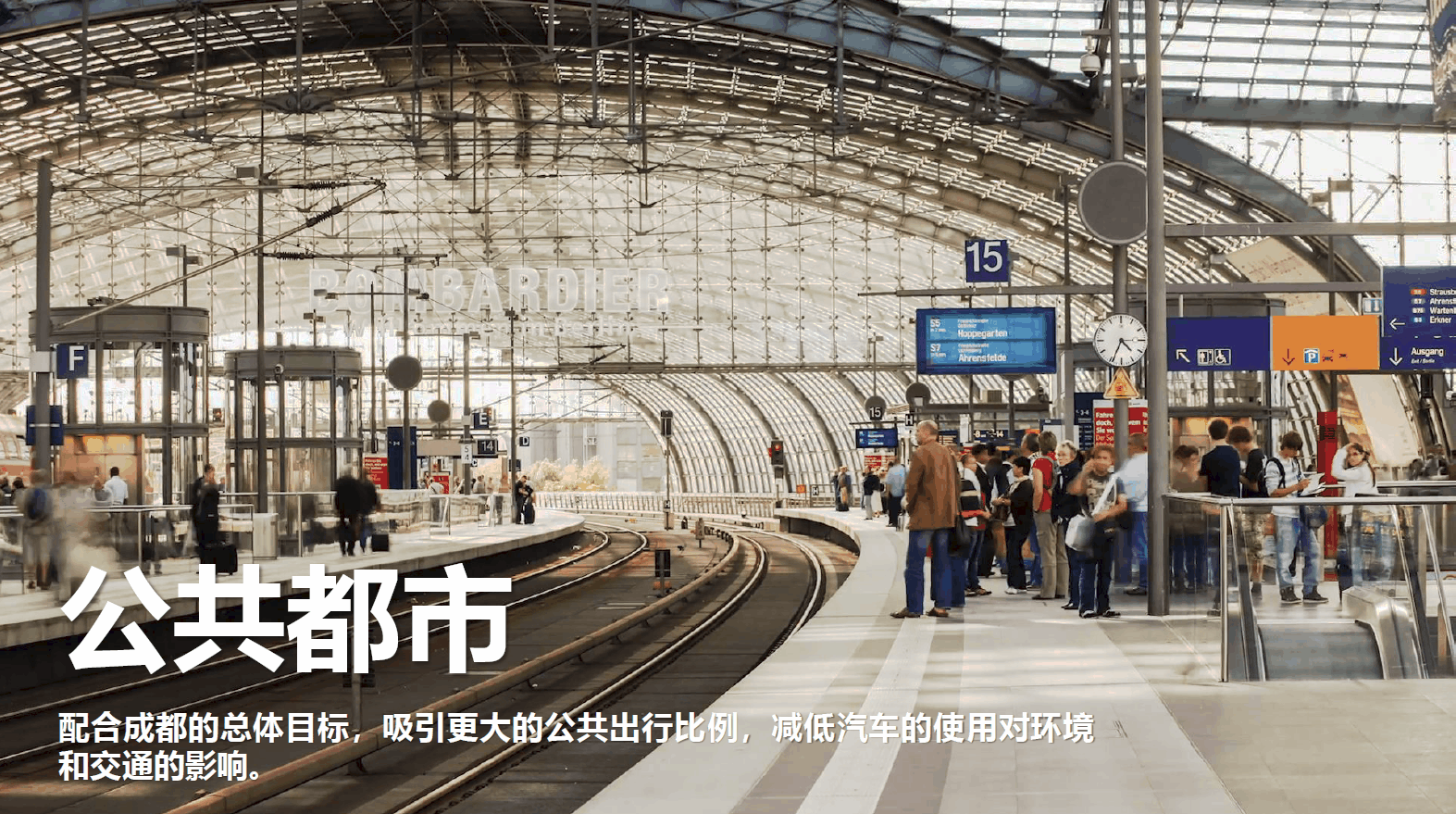
采用“一核一带两轴多点”的空间结构,以升仙湖为TOD综合核心,沿湖规划生态休闲带,并形成活力水岸商业轴和城市公园生态绿轴。
Adopting the spatial structure of "one core, one belt, two axes and multiple points", with Shengxianhu Lake as the comprehensive core of TOD, an ecological leisure belt is planned along the lake, and a dynamic waterfront commercial axis and an ecological green axis of the urban park are formed.


以北部湖景为起点,引入湖水,形成水景观环路,并沿主水轴向四周渗透。在保证主绿化轴公园景观整体性的同时,设计屋顶花园,垂直绿化,退台花园,呼应绿色 TOD 的主要设计理念。
Starting from the northern lake landscape, the lake water is introduced to form a water landscape loop, which infiltrates around the main water axis. While ensuring the integrity of the main greening axis park landscape, the design of roof gardens, vertical greening, and terrace gardens echoes the main design concept of green TOD.

采用快慢结合的 TOD 片区式开发,以车站建筑为核心,设置合理的功能分区,紧邻车站的区域设为活力商业区域,并且将临近景观视野较好的区域设为高端住宅区。各种商业形态在时间和空间上得以交错与互补满足不同消费人群的偏好与效用,使地铁带动的商圈在 24 小时内发生着满足不同人群的活动。充分利用地下空间,对接地铁人流,形成站厅商铺、通道商铺和地下商业街等多种商业业态。地上空间高密度开发,满足地铁带动多样化的商业及商务需求对土地空间的需求。结合多层次的二层空中景观连廊系统,形成创新的连续融合的开放空间生态系统。
The TOD area-style development that combines speed and slowness is adopted, with the station building as the core, and reasonable functional divisions are set up. The area adjacent to the station is set as a dynamic commercial area, and the area with a good view of the adjacent landscape is set as a high-end residential area. Various commercial forms can be interleaved and complemented in time and space to meet the preferences and utility of different consumer groups, so that the subway-driven business district has activities to meet different groups of people within 24 hours. Make full use of the underground space to connect with the flow of people in the subway, and form a variety of commercial formats such as station hall shops, channel shops and underground commercial streets. The high-density development of above-ground space meets the demand for land space driven by the diverse commercial and business needs of the subway. Combined with the multi-level two-story aerial landscape corridor system, an innovative continuous and integrated open space ecosystem is formed.


设计四大亮点
步行优先的交通体系
Pedestrian-first transportation system
贯彻TOD设计理念,以升仙湖地铁站为核心,优化对外交通系统,分三个层级对道路进行规划,保证各地块之间的可达性。其次,将公交枢纽换乘站、出租车站点与升仙湖站一体化设计,满足枢纽换乘需求,并按照合适的服务半径,规划公交站点,提升公交覆盖率,快速疏散人流。构建完善的慢行系统,沿绿廊布局步行道和自行车道,在地面二层形成空中连廊系统,优化行人过路方式。在基地内提倡步行出行,减少车流量,优化私家车路线,在项目研究范围内部部分道路禁止私家车入内,减低汽车的使用对环境和交通的影响。
Implementing the TOD design concept, taking Shengxianhu subway station as the core, optimizing the external transportation system, and planning the roads in three levels to ensure the accessibility between various blocks. Secondly, integrate the bus hub transfer station, taxi station and Shengxianhu station to meet the transfer needs of the hub, and plan bus stations according to the appropriate service radius to improve bus coverage and quickly evacuate people. Build a complete slow-moving system, lay out walking paths and bicycle paths along the green corridor, and form an air corridor system on the second floor on the ground to optimize the way pedestrians pass. In the base, it is recommended to travel by foot, reduce the traffic flow, optimize the routes of private cars, and prohibit private cars from entering some roads within the project research scope, so as to reduce the impact of car use on the environment and traffic.
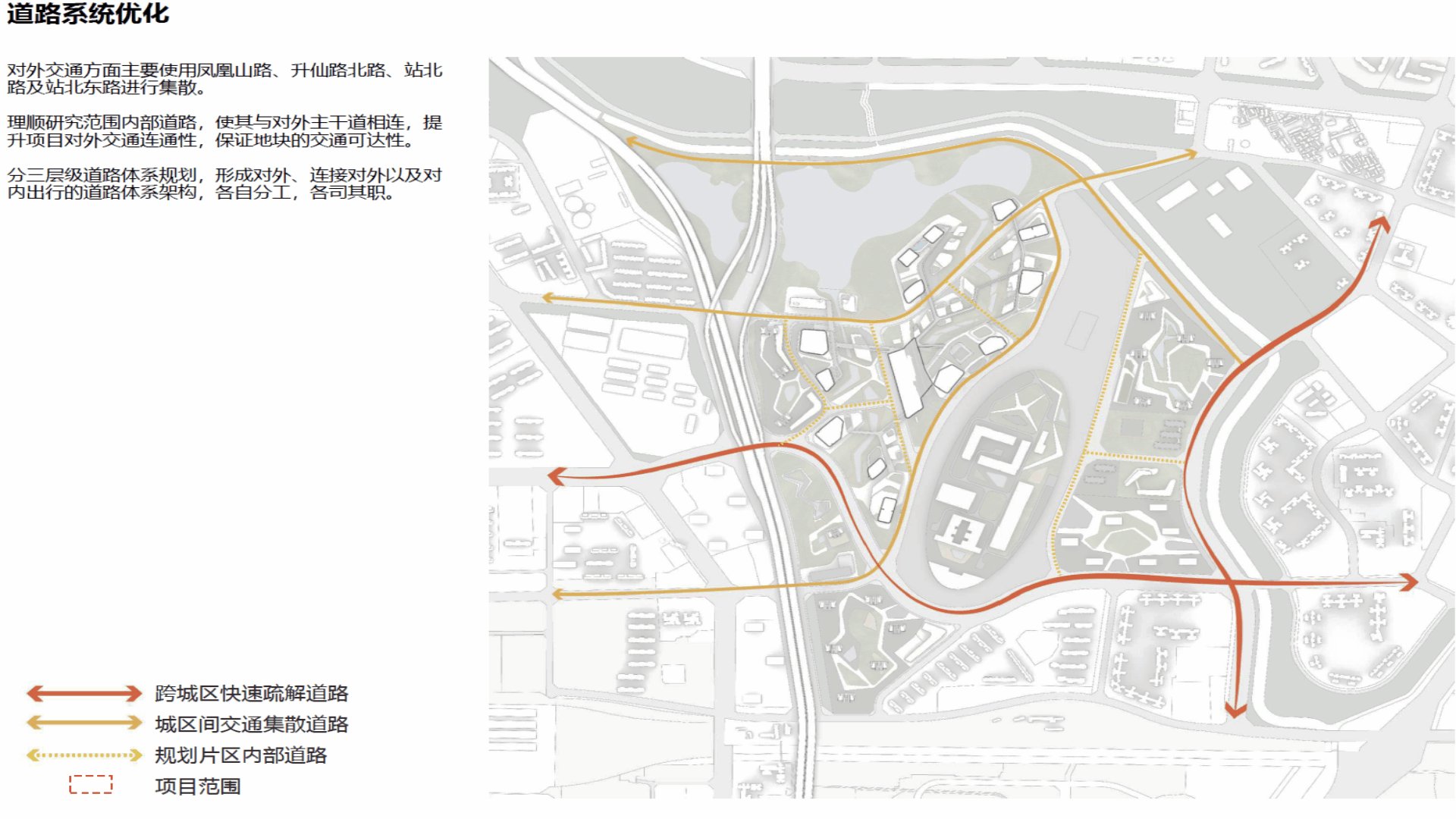

整体设计秉承站城一体的理念,分别对于城市风貌,天际线进行控制,通过裙房的设置,复合了多种功能,通过未来TOD 一体化设计所带来的人流红利,将会对片区产业进行整体的提升,升仙湖站将会成为成华区又一个生活枢纽,而改造后的片区内200 米高层将会结合片区特色发展成为地标式的建筑物,对于地标的建筑物进行有限度的艺术设计。
The overall design adheres to the concept of integrating the station and the city, and controls the urban style and skyline respectively. Through the setting of the podium, a variety of functions are combined. With the overall improvement, Shengxian Lake Station will become another living hub in Chenghua District, and the 200-meter high-rise in the renovated area will be developed into a landmark building in combination with the characteristics of the area, and limited art will be carried out on the landmark buildings. design.


绿色城市公园、活力水岸商业
Design Highlights - Green City Parks, Vibrant Waterfront Businesses
人流规模效应催生范围经济,促进商圈内衍生多元化商业模式。通过打通站城东侧发展区域与升仙湖的直接连接,形成生态发展轴,在沿轴两侧布置相应所需产业,打造舒适宜居的绿色复合空间。采用城市绿楔的规划策略,将绿色嵌入基地之中,强化城市景观,构建立体绿化系统。沿河道设计商业盒子,聚集人气,打造水岸商业活力空间。
The scale effect of the flow of people generates economies of scope and promotes the derivation of diversified business models in the business circle. By opening up the direct connection between the development area on the east side of the station city and Shengxian Lake, an ecological development axis is formed, and corresponding required industries are arranged on both sides of the axis to create a comfortable and livable green complex space. Adopt the urban green wedge planning strategy, embed green into the base, strengthen the urban landscape, and build a three-dimensional greening system. Design commercial boxes along the river to gather popularity and create a commercial vitality space along the waterfront.


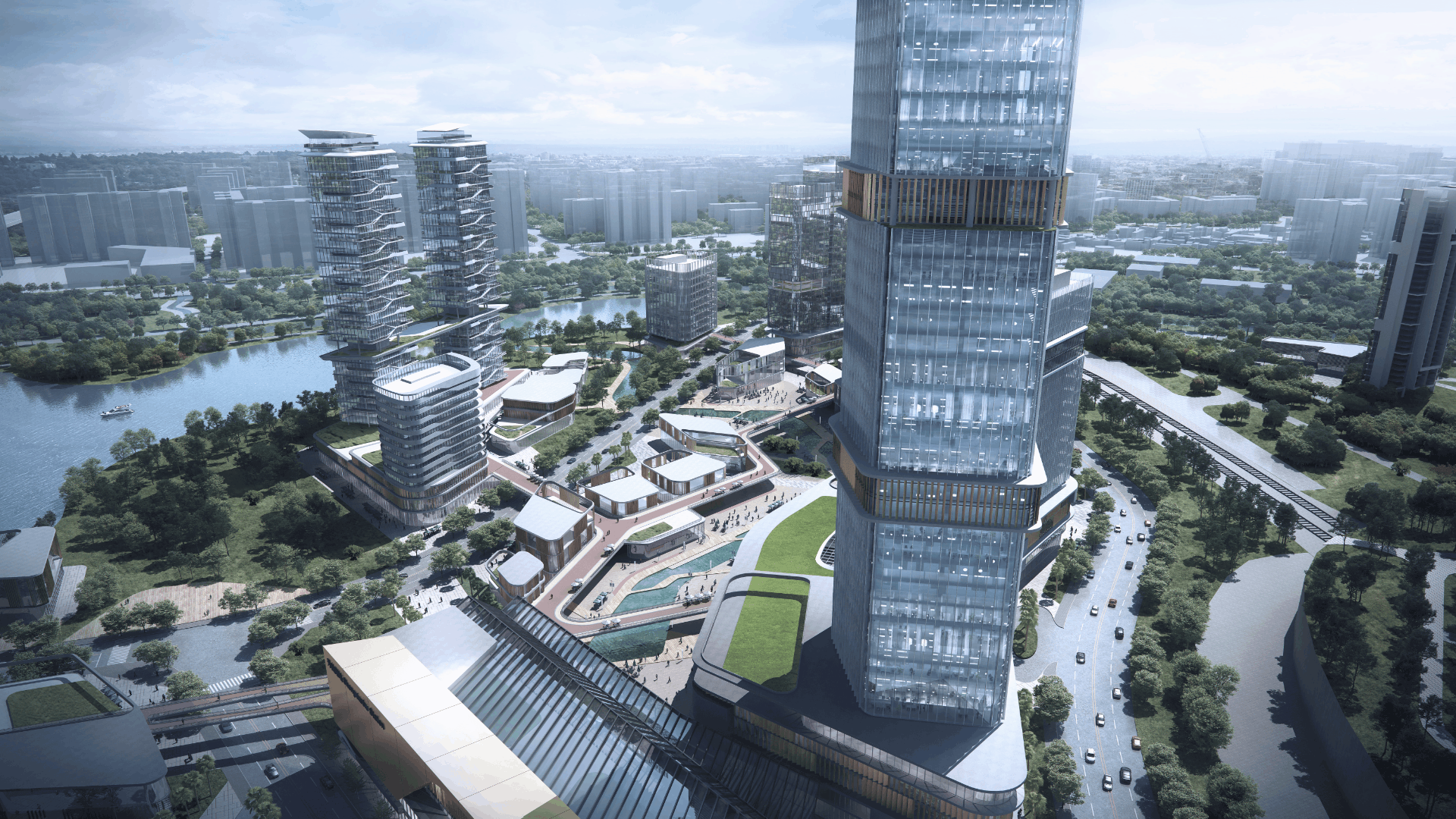
门户地标
Gateway Landmark
200米高的地标塔楼坐落于升仙湖地铁站西侧,位于主入口前广场,形成站前地标形象。主塔区围绕围绕中央花园景观和湖景布局,保证最大化景观,并有效削减停车段的消极影响。商业裙楼与塔楼采用退台式设计,将公共开放空间与商业完美结合,通过空中连廊与地铁连接成一体,构建成核心商务区域。
The 200-meter-high landmark tower is located on the west side of Shengxianhu Metro Station, in the square in front of the main entrance, forming a landmark image in front of the station. The main tower area is arranged around the central garden landscape and lake view to maximize the landscape and effectively reduce the negative impact of the parking section. The commercial podium and tower are designed with a setback, which perfectly combines the public open space and business, and is connected with the subway through the sky corridor to form a core business area.

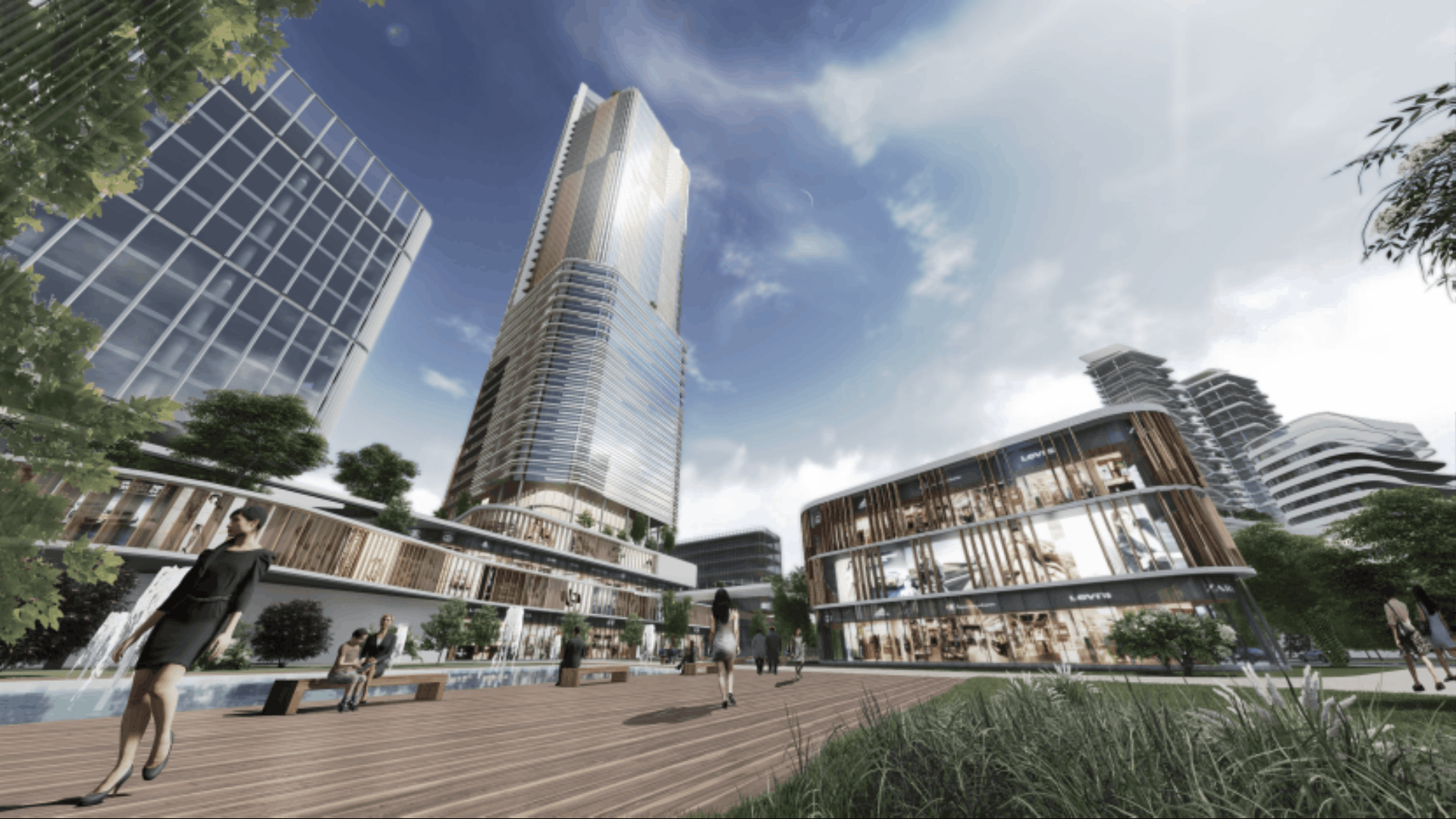
绿色一体化车站建筑改造
Renovation of Green Integrated Station Buildings
在保留地铁站原建筑结构和首层设备功能下,对其站内空间、车站内外流线进行优化。将地铁站二层和三层设计为开放的公共商业空间,并通过连桥有效的与周边地块建筑衔接,引导人流走向。配合整体公园城市的设计理念,在立面上通过木质百叶的造型设计形成建筑遮阳体系,并以绿色植物作为室内空间装饰,打造绿色TOD一体化的典范。
While retaining the original building structure of the subway station and the functions of the equipment on the first floor, the space inside the station and the circulation inside and outside the station are optimized. The second and third floors of the subway station are designed as open public commercial spaces, and are effectively connected to the surrounding plot buildings through connecting bridges to guide the flow of people. In line with the design concept of the overall park city, the building shading system is formed through the shape design of wooden louvers on the facade, and green plants are used as interior space decoration to create a model of green TOD integration.


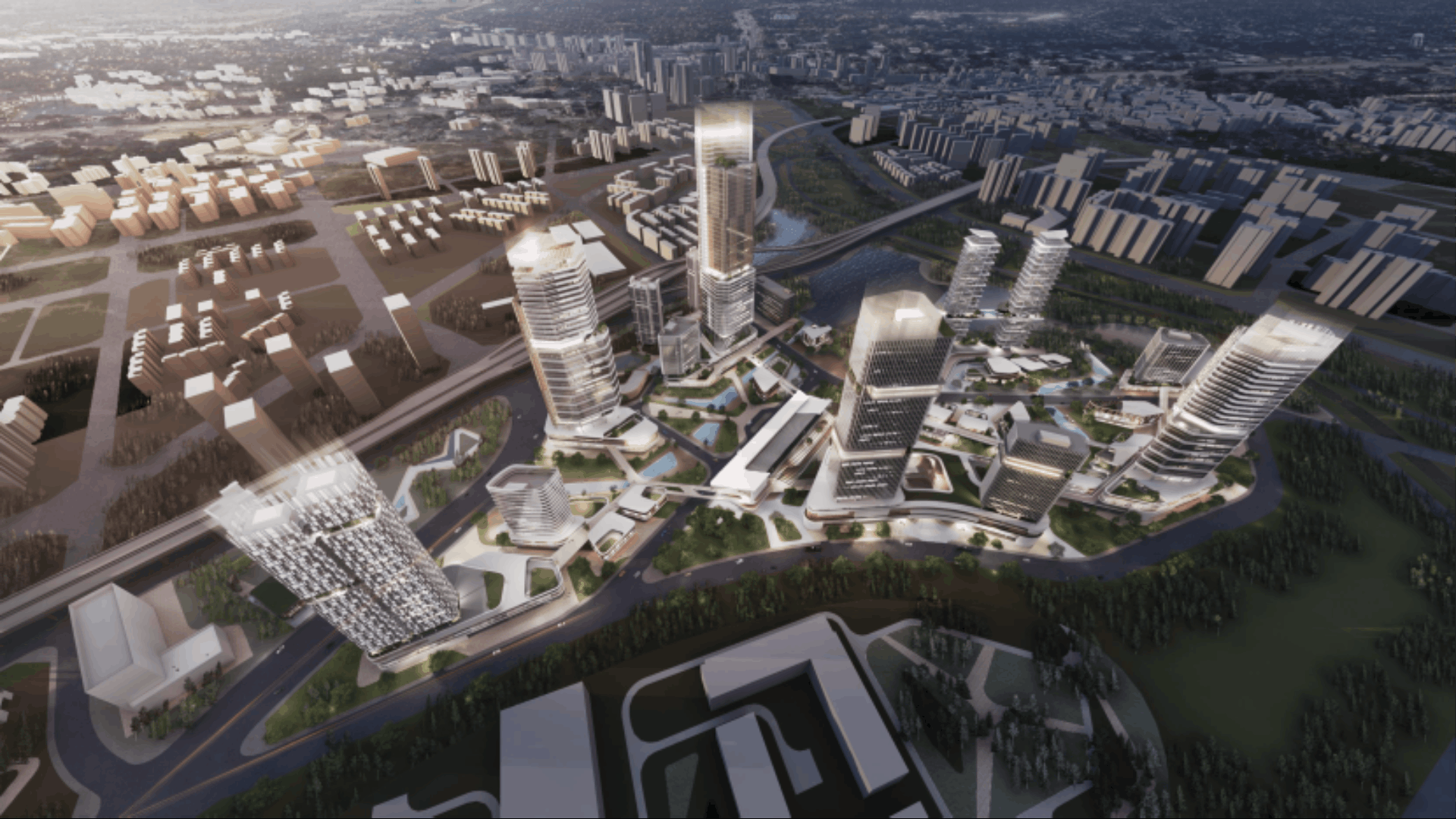
THE END
版权声明:
“PMA”, “PLACE MAKING ARCHITECTS”, “都市空间”皆为PLACE MAKING ARCHITECTS (PMA) INTERNATIONAL LIMITED注册商标。
©版权所有 All Rights Reserved PLACE MAKING ARCHITECTS(PMA) INTENATIONLA LIMITED
